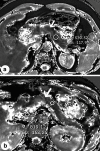T1 mapping for the diagnosis of early chronic pancreatitis: correlation with Cambridge classification system
- PMID: 33861154
- PMCID: PMC8506175
- DOI: 10.1259/bjr.20200685
T1 mapping for the diagnosis of early chronic pancreatitis: correlation with Cambridge classification system
Abstract
Objective: This study aims to determine if T1 relaxation time of the pancreas can detect parenchymal changes in early chronic pancreatitis (CP).
Methods: This study retrospectively analyzed 42 patients grouped as no CP (Cambridge 0; n = 21), equivocal (Cambridge 1; n = 12) or mild CP (Cambridge 2; n = 9) based on magnetic resonance cholangiopancreatography findings using the Cambridge classification as the reference standard. Unenhanced T1 maps were acquired using a three-dimensional dual flip-angle gradient-echo technique on the same 1.5 T scanner with the same imaging parameters.
Results: There was no significant difference between the T1 relaxation times of Cambridge 0 and 1 group (p = 0.58). There was a significant difference (p = 0.0003) in the mean T1 relaxation times of the pancreas between the combined Cambridge 0 and 1 (mean = 639 msec, 95% CI: 617, 660) and Cambridge 2 groups (mean = 726 msec, 95% CI: 692, 759). There was significant difference (p = 0.0009) in the mean T1 relaxation times of the pancreas between the Cambridge 0 (mean = 636 msec, 95% CI: 606, 666) and Cambridge 2 groups (mean = 726 msec, 95% CI: 692,759) as well as between Cambridge 1 (mean = 643 msec, 95% CI: 608, 679) and Cambridge 2 groups (mean = 726 msec, 95% CI: 692,759) (p = 0.0017). Bland-Altman analysis showed measurements of one reader to be marginally higher than the other by 15.7 msec (2.4%, p = 0.04).
Conclusion: T1 mapping is a practical method capable of quantitatively reflecting morphologic changes even in the early stages of chronic pancreatitis, and demonstrates promise for future implementation in routine clinical imaging protocols.
Advances in knowledge: T1 mapping can distinguish subtle parenchymal changes seen in early stage CP, and demonstrates promise for implementation in routine imaging protocols for the diagnosis of CP.
Figures



References
MeSH terms
Grants and funding
LinkOut - more resources
Full Text Sources
Other Literature Sources
Miscellaneous

